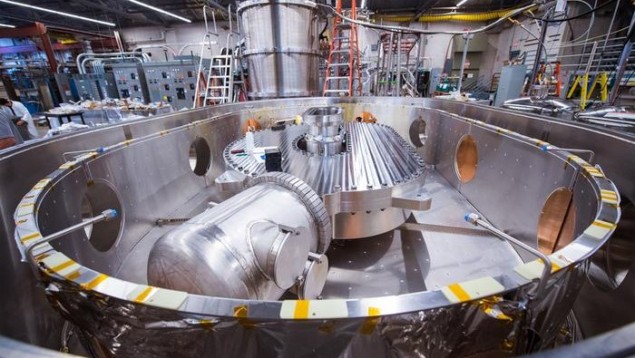REBCO high-temperature superconductors are ideal for tokamak magnets, study suggests
04 Apr 2024
Tokamak bound: the new magnets at the PSFC test facility. They achieved a world-record magnetic field strength of 20 T for a large-scale magnet. (Courtesy: Gretchen Ertl)
An extensive study done in the US has confirmed that magnets made from rare earth barium copper oxide (REBCO) high-temperature superconductors are ideal for confining plasma in future fusion experiments. The team showed that the magnets are both robust and compact, making them a practical option for future tokamaks such as SPARC, which is being developed by Commonwealth Fusion Systems (CFS) and MIT’s Plasma Science Fusion Centre (PSFC).
The study was done by researchers at CFS and PSFC, who created new diagnostic instruments for studying the magnets.
A tokamak fusion reactor uses very strong magnetic fields to confine a hydrogen plasma inside its doughnut-shaped interior. This allows the plasma to be heated to very high temperatures so that hydrogen nuclei fuse together – releasing large amounts of energy. The ultimate goal of tokamak research is to get much more energy out of fusing plasma than is put in, thus creating a relatively clean source of energy.
These magnetic fields are created by electromagnets and in existing tokamaks, these are wound using wires made from a conventional conductor (copper) or a low-temperature superconductor. Both approaches have advantages and limitations, so fusion researchers are keen on exploring other magnet options. In particular, most existing magnet technologies would be too big and too expensive for use in next-generation devices that will require higher field levels.
Limited fields
“Superconducting magnets with very low power consumption have now been integrated into fusion devices at sufficient scales,” explains Zach Hartwig at MIT, who led the new analysis. “However, they have all used superconductors that were limited to confining magnetic field strengths of approximately 5 T.” Even when confined at these fields, plasma will gradually leak out.
Between 2018 and 2021, a collaboration of researchers at PSFC and CFS developed REBCO magnets with the aim of boosting confining fields – and material’s performance was very promising.
“REBCO is capable of producing extremely high magnetic fields, and can also carry very high electrical current densities at temperatures up to 20 K,” Hartwig explains. “This leads to superior engineering and performance in superconducting magnets.”
Now Hartwig and colleagues report the results of a comprehensive battery of tests of REBCO’s performance as a superconducting magnet, using purpose-built test facilities at MIT.
Nearly double
Through experiments carried out in September 2021, the material demonstrated a peak magnetic field of over 20 T. This is almost double the highest fields achieved previously in other superconducting magnets for similar applications.
Since then, the researchers have carried out further tests that pushed a REBCO magnet to extreme limits of its performance, while doing an analysis of its operation.
The team now present their findings in a series of papers in IEEE Transactions on Applied Superconductivity. They provide an in-depth description of all of the magnet’s components and how they performed at high fields. Hartwig’s team are now confident that REBCO is well suited for its intended purpose.
“Despite the enormous electromechanical loads, the electrical, thermal, and structural performance of the magnet behaved exactly as designed in steady-state operation,” Hartwig says. “This validated the advanced computational modelling developed in the programme, and experimentally confirmed that high-field superconducting magnets are viable for fusion energy,” he adds.
Much smaller volume
Crucially, the experiments demonstrated that REBCO is capable of sustaining a 12 T field suitable for plasma confinement within a volume some 30 to 40 times smaller than previous fusion devices.
“The significant reduction in scale enabled by REBCO will enable lower costs and faster schedules to build magnetic confinement devices, as well as more favourable economics for fusion energy power plants,” Hartwig explains.
“Perhaps most importantly, the reduced scale enables a critical transition in fusion energy: moving from multi-national, government-funded science programs into privately funded, mission-driven companies, focused on commercializing a viable new zero carbon energy source,” he adds.
Based on their promising findings, the PSFC and CFS teams now hope their analysis will serve as a valuable guide for future fusion research: perhaps bringing one of the most long-awaited goals in physics a step closer to reality.
Sam Jarman is a science writer based in the UK
FROM PHYSICSWORLD.COM 9/4/2024

Δεν υπάρχουν σχόλια:
Δημοσίευση σχολίου